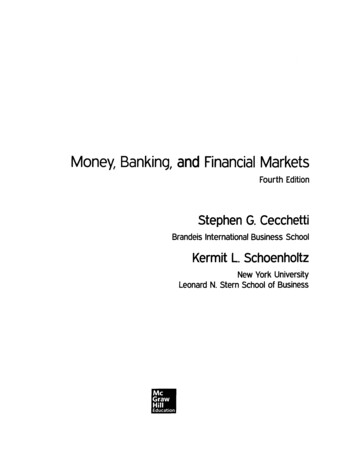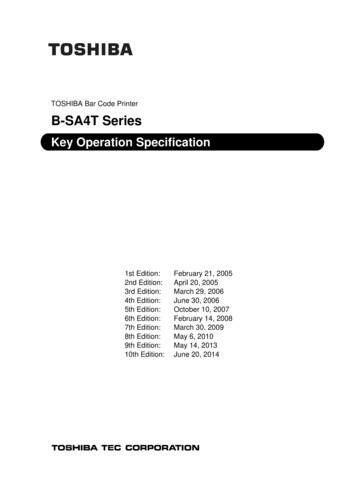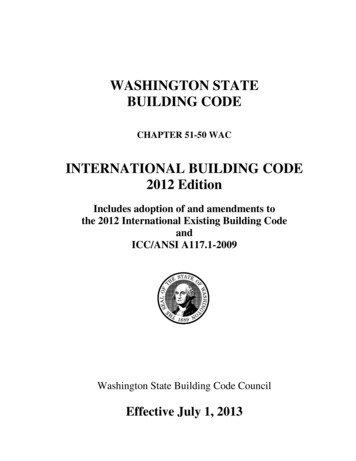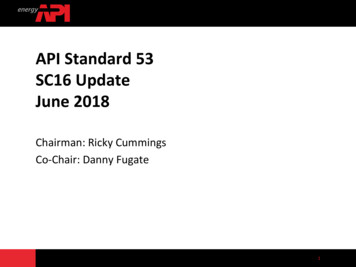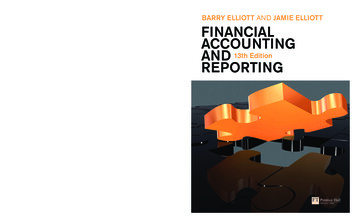
Transcription
13thEDITIONELLIOTT AND ELLIOTTFinancial Accounting & Reporting is the most up-to-date text on the market. Now fully updated inits 13th edition, it includes extensive coverage of International Accounting Standards (IASs) andInternational Financial Reporting Standards (IFRSs).This market-leading text offers students a clear, well-structured and comprehensive treatmentof the subject. Supported by illustrations and exercises, the book provides a strong balance oftheoretical and conceptual coverage. Students using this book will gain the knowledge and skillsto help them apply current standards, and critically appraise the underlying concepts and financialreporting methods.Key featureslllllllFINANCIALACCOUNTINGAND 13th EditionREPORTINGNew features for this editionllllllFully updated to May 2009Updated coverage of InternationalFinancial Reporting StandardsSubstantial revisions to Analysis ofAccounts and Accountability chaptersSelected chapters include new additionalquestions and exercisesIncludes more examples of extracts fromreal financial reportsFully supported by a comprehensive setof multiple-choice questions online,covering all parts of the text.FINANCIAL ACCOUNTINGAND REPORTINGlCombines academic rigour with anengaging and accessible styleCoverage of International FinancialReporting StandardsIllustrations taken from real publishedaccountsExcellent range of review questionsNumerous exercises, varying in level ofdifficulty, with solutions where applicableExtensive referencesA section on the Analysis of AccountsA section on Accountability – includesCorporate Governance issues,Sustainability - environmental andsocial reporting and EthicsBARRY ELLIOTT AND JAMIE ELLIOTTBarry Elliott is a training consultant. He has extensive teaching experience at undergraduate,postgraduate and professional level in China, Hong Kong, New Zealand and Singapore. He haswide experience as an external examiner both in higher education and at all levels of professionaleducation.Jamie Elliott is a Director with Deloitte & Touche. Prior to this he has lectured at university onundergraduate degree programmes and as an assistant professor on MBA and Executiveprogrammes at the London Business School.Cover image alamywww.pearson-books.comCVR ELLI3325 13 SE CVR.indd 18/7/09 14:12:16
A01 ELLI3325 13 SE FM.QXD13/7/0911:24Page iFinancial Accountingand Reporting
A01 ELLI3325 13 SE FM.QXD13/7/0911:24Page iiWe work with leading authors to develop thestrongest educational materials in business and financebringing cutting-edge thinking and best learningpractice to a global market.Under a range of well-known imprints, includingFinancial Times Prentice Hall we craft highquality print and electronic publications which helpreaders to understand and apply their content,whether studying or at work.To find out more about the complete range of ourpublishing, please visit us on the World Wide Web at:www.pearsoned.co.uk
A01 ELLI3325 13 SE FM.QXD13/7/0911:24Page iiiOpenmirrors.comFinancial Accountingand ReportingTHIRTEENTH EDITIONBarry Elliott and Jamie Elliott
A01 ELLI3325 13 SE FM.QXD13/7/0911:24Page ivOpenmirrors.comPearson Education LimitedEdinburgh GateHarlowEssex CM20 2JEEnglandand Associated Companies throughout the worldVisit us on the World Wide Web at:www.pearsoned.co.ukFirst published 1993Second edition 1996Third edition 1999Fourth edition 2000Fifth edition 2001Sixth edition 2002Seventh edition 2003Eighth edition 2004Ninth edition published 2005Tenth edition published 2006Eleventh edition published 2007Twelfth edition published 2008Thirteenth edition published 2009 Prentice Hall International UK Limited 1993, 1999 Pearson Education Limited 2000, 2009The rights of Barry Elliott and Jamie Elliott to be identified as authors of thiswork have been asserted by them in accordance with the Copyright, Designsand Patents Act 1988.All rights reserved. No part of this publication may be reproduced, stored in aretrieval system, or transmitted in any form or by any means, electronic,mechanical, photocopying, recording or otherwise, without either the priorwritten permission of the publisher or a licence permitting restricted copyingin the United Kingdom issued by the Copyright Licensing Agency Ltd, SaffronHouse, 6–10 Kirby Street, London EC1N 8TS.All trademarks used herein are the property of their respective owners. Theuse of any trademark in this text does not vest in the author or publisher anytrademark ownership rights in such trademarks, nor does the use of suchtrademarks imply any affiliation with or endorsement of this book by suchowners.ISBN: 978-0-273-72332-5British Library Cataloguing-in-Publication DataA catalogue record for this book is available from the British LibraryLibrary of Congress Cataloging-in-Publication Data10139 8 7 612 11 105 409321Typeset in 10/12 Ehrhardt MT by 35Printed by Ashford Colour Press Ltd., GosportThe publisher’s policy is to use paper manufactured from sustainable forests.
A01 ELLI3325 13 SE FM.QXD13/7/0911:24Page vOpenmirrors.comBrief ContentsPreface and acknowledgementsGuided tour of MyAccountingLabxxixxviPart 1INCOME AND ASSET VALUE MEASUREMENT SYSTEMS12341Accounting and reporting on a cash flow basisAccounting and reporting on an accrual accounting basisIncome and asset value measurement: an economist’s approachAccounting for inflation3224059Part 2REGULATORY FRAMEWORK – AN ATTEMPT TO ACHIEVEUNIFORMITY9956789Financial reporting – evolution of the regulatory framework in the UKFinancial reporting – evolution of international standardsConceptual frameworkPublished accounts of companiesPreparation of published accounts101137158184229Part 3STATEMENT OF FINANCIAL POSITION – EQUITY, LIABILITYAND ASSET MEASUREMENT AND 2436457498524Share capital, distributable profits and reduction of capitalOff balance sheet financeFinancial instrumentsEmployee benefitsTaxation in company accountsProperty, plant and equipment (PPE)LeasingR&D; goodwill and intangible assets; brandsInventoriesConstruction contractsOpenmirrors.com
A01 ELLI3325 13 SE FM.QXD13/7/0911:24Page viOpenmirrors.comvi Brief ContentsPart 4CONSOLIDATED ACCOUNTS20 Accounting for groups at the date of acquisition21 Preparation of consolidated statements of financial position after the dateof acquisition22 Preparation of consolidated statements of comprehensive income andconsolidated statements of changes in equity23 Accounting for associates and joint ventures24 Accounting for the effects of changes in foreign exchange rates under IAS 21543545562575591611Part s per shareStatements of cash flowsReview of financial ratio analysisTrend analysis and multivariate analysisAn introduction to financial reporting on the InternetPart 6ACCOUNTABILITY78330 Corporate governance31 Sustainability – environmental and social reporting32 Ethics for accountants785838884Appendix: Outline solutions to selected exercises907Index913
A01 ELLI3325 13 SE FM.QXD13/7/0911:24Page viiOpenmirrors.comFull ContentsPreface and acknowledgementsGuided tour of MyAccountingLabxxixxviPart 1INCOME AND ASSET VALUE MEASUREMENT SYSTEMS1 Accounting and reporting on a cash flow uctionShareholdersWhat skills does an accountant require in respect of external reports?ManagersWhat skills does an accountant require in respect of internal reports?Procedural steps when reporting to internal usersAgency costsIllustration of periodic financial statements prepared under the cashflow concept to disclose realised operating cash flowsIllustration of preparation of balance sheet under the cash flow conceptTreatment of non-current assets in the cash flow modelWhat are the characteristics of these data that make them reliable?Reports to external usersSummaryReview questionsExercisesReferences2 Accounting and reporting on an accrual accounting ical cost conventionAccrual basis of accountingMechanics of accrual accounting – adjusting cash receipts and paymentsSubjective judgements required in accrual accounting – adjusting cashreceipts in accordance with lAS 18Subjective judgements required in accrual accounting – adjusting cashpayments in accordance with the matching principleMechanics of accrual accounting – the statement of financial positionReformatting the statement of financial positionAccounting for the sacrifice of non-current 29
A01 ELLI3325 13 SE FM.QXD13/7/0911:24Page viiiOpenmirrors.comviii Full Contents2.10Reconciliation of cash flow and accrual accounting dataSummaryReview questionsExercisesReferences3 Income and asset value measurement: an tionRole and objective of income measurementAccountant’s view of income, capital and valueCritical comment on the accountant’s measureEconomist’s view of income, capital and valueCritical comment on the economist’s measureIncome, capital and changing price levelsSummaryReview questionsExercisesReferencesBibliography4 Accounting for uctionReview of the problems of historical cost accounting (HCA)Inflation accountingThe concepts in principleThe four models illustrated for a company with cash purchasesand salesCritique of each modelOperating capital maintenance – a comprehensive exampleCritique of CCA statementsThe ASB approachThe IASC/IASB approachFuture developmentsSummaryReview questionsExercisesReferencesBibliographyPart 2REGULATORY FRAMEWORK – AN ATTEMPT TOACHIEVE UNIFORMITY5 Financial reporting – evolution of the regulatory frameworkin the UK5.15.25.35.4IntroductionMandatory regulationsArguments in support of standardsArguments against 9606061656879818384868788979799101101101105106
A01 ELLI3325 13 SE FM.QXD13/7/0911:24Page ixOpenmirrors.comFull Contents ix5.55.65.75.85.95.105.115.12Structure of regulatory frameworkThe Operating and Financial Review (OFR)The Financial Reporting Review PanelThe Financial Services AuthorityThe Revised Combined Code ( June 2008)Interim reports following CadburyDevelopments for small companiesEvaluation of effectiveness of mandatory regulationsSummaryReview questionsExercisesReferences6 Financial reporting – evolution of international standards6.16.26.36.46.56.66.7IntroductionNational differencesReasons for differences in financial reportingClassification of national accounting systemsAttempts to reduce national differencesThe work of international bodies in harmonising and standardisingfinancial reportingUS GAAPSummaryReview questionsExercisesReferences7 Conceptual framework7.17.27.37.47.57.6IntroductionHistorical overview of the evolution of financial accounting theoryIASC Framework for the Presentation and Preparation of FinancialStatementsASB Statement of Principles 1999FASB Statements of Financial Accounting ConceptsConceptual Framework developmentsSummaryReview questionsExercisesReferences8 Published accounts of tion to published accountsA public company’s financial calendarCriteria for information appearing in a statement of comprehensiveincome and statement of financial positionThe prescribed formats – the statement of comprehensive incomeWhat information is required to be disclosed in Format 1 andFormat 2?Cost of 8180181182184184184186186187188189
A01 ELLI3325 13 SE FM.QXD13/7/0911:24Page xx Full 8.198.208.218.228.238.24Distribution costsAdministrative expensesOther operating income or expenseWhat costs and income are brought into account after calculatingthe trading profit in order to arrive at the profit on ordinaryactivities before tax?Does it really matter under which heading a cost is classified in thestatement of comprehensive income provided it is not omitted?Discontinued operations disclosure in the statement ofcomprehensive incomeItems requiring separate disclosureOther comprehensive incomeThe prescribed formats – the statement of financial positionStatement of changes in equityUS comprehensive income reportingSegment reportingThe fundamental accounting principles underlying the publishedstatement of comprehensive income and statement of financialpositionDisclosure of accounting policiesFair view treatmentAdditional information in the annual reportWhat information do companies provide to assist comparisonbetween companies reporting under different reporting regimes?SummaryReview questionsExercisesReferences9 Preparation of published accounts9.19.29.39.49.59.69.7IntroductionStage 1: preparation of the internal statement of comprehensiveincome from a trial balanceStage 2: preparation of the statement of comprehensive incomeof Illustrious SpA in Format 1 styleStage 3: preparation of the statement of financial positionPreparation of accounts in Format 1 following IAS 8 and IFRS 5Additional information value of IFRS 5Additional information value of IAS 24SummaryReview 231234235239240242243243254Part 3STATEMENT OF FINANCIAL POSITION – EQUITY,LIABILITY AND ASSET MEASUREMENT AND DISCLOSURE25510 Share capital, distributable profits and reduction of capital25710.1Introduction257
A01 ELLI3325 13 SE FM.QXD13/7/0911:24Page xiFull Contents 0.1310.1410.15Common themesTotal owners’ equity: an overviewTotal shareholders’ funds: more detailed explanationAccounting entries on issue of sharesCreditor protection: capital maintenance conceptCreditor protection: why capital maintenance rules are necessaryCreditor protection: how to quantify the amounts available to meetcreditors’ claimsIssued share capital: minimum share capitalDistributable profits: general considerationsDistributable profits: how to arrive at the amount using relevant accountsWhen may capital be reduced?Writing off part of capital which has already been lost and is notrepresented by assetsRepayment of part of paid-in capital to shareholders or cancellationof unpaid share capitalPurchase of own sharesSummaryReview questionsExercisesReferences11 Off balance sheet .11IntroductionTraditional statements – conceptual changesPrimary financial statements: their interrelationshipPrimary financial statements: changes in their interrelationshipReasons that companies borrowCapital gearing and its implicationsOff balance sheet finance – its impactSubstance over formImpact of converting to IFRSStatement of financial position as a valuation documentWhy companies take steps to strengthen their statements offinancial position11.12 Definitions cannot remove uncertainty: IAS 10 and IAS 3711.13 ED IAS 37 Non-financial LiabilitiesSummaryReview questionsExercisesReferences12 Financial al instruments – the IASB’s problem childIAS 32 Financial Instruments: Disclosure and PresentationIAS 39 Financial Instruments: Recognition and MeasurementIFRS 7 Financial Statement DisclosuresSummaryReview 96304310311313316317317317320325335338339
A01 ELLI3325 13 SE FM.QXD13/7/0911:24Page xiixii Full ContentsExercisesReferences13 Employee 3.2113.2213.2313.24IntroductionGreater employee interest in pensionsFinancial reporting implicationsTypes of schemeDefined contribution pension schemesDefined benefit pension schemesIAS 19 (revised) Employee BenefitsThe liability for pension and other post-retirement costsThe statement of comprehensive incomeComprehensive illustrationPlan curtailments and settlementsMulti-employer plansDisclosuresOther long-service benefitsShort-term benefitsTermination benefitsIFRS 2 Share-Based PaymentScope of IFRS 2Recognition and measurementEquity-settled share-based paymentsCash-settled share-based paymentsTransactions which may be settled in cash or sharesTransitional provisionsIAS 26 Accounting and Reporting by Retirement Benefit PlansSummaryReview questionsExercisesReferences14 Taxation in company 4.1114.12IntroductionCorporation taxCorporation tax systems – the theoretical backgroundCorporation tax systems – avoidance and evasionCorporation tax – the system from 6 April 1999IFRS and taxationIAS 12 – accounting for current taxationDeferred taxFRS 19 (the UK standard on deferred taxation)A critique of deferred taxationExamples of companies following IAS 12Value added tax (VAT)SummaryReview 0391394396397397398400
A01 ELLI3325 13 SE FM.QXD13/7/0911:24Page xiiiFull Contents xiii15 Property, plant and equipment 115.1215.1315.1415.1515.16IntroductionPPE – concepts and the relevant IASs and IFRSsWhat is PPE?How is the cost of PPE determined?What is depreciation?What are the constituents in the depreciation formula?How is the useful life of an asset determined?Residual valueCalculation of depreciationMeasurement subsequent to initial recognitionIAS 36 Impairment of AssetsIFRS 5 Non-Current Assets Held for Sale and Discontinued OperationsDisclosure requirementsGovernment grants towards the cost of PPEInvestment propertiesEffect of accounting policy for PPE on the interpretation of thefinancial statementsSummaryReview 0941041041441642242242342542642842842943516 kground to leasingIAS 17 (and its national equivalents) – the controversyIAS 17 – classification of a leaseIAS 17 – accounting for leases by lesseesAccounting for the lease of land and buildingsLeasing – a form of off statement of financial position financingAccounting for leases – a new approachAccounting for leases by lessorsSummaryReview questionsExercisesReferences17 R&D; goodwill and intangible assets; 11IntroductionAccounting treatment for research and developmentResearch and developmentIntroduction to goodwill and intangible assetsAccounting for goodwill under IFRS 3Is there a correct treatment for amortising goodwill?Accounting for intangible assets under IAS 38Disclosure of intangible assets under IAS 38Brand accountingEmissions tradingIntellectual property457457457459463463466471473476478480
A01 ELLI3325 13 SE FM.QXD13/7/0911:24Page xivxiv Full Contents17.12 Intellectual capital17.13 Review of implementation of IFRS 3SummaryReview questionsExercisesReferences18 1018.11IntroductionInventory definedThe controversyIAS 2 InventoriesInventory valuationWork-in-progressInventory controlCreative accountingAudit of the year-end physical inventory countPublished accountsAgricultural activitySummaryReview questionsExercisesReferences19 Construction 29535535535542PART 4CONSOLIDATED ACCOUNTS54320 Accounting for groups at the date of Openmirrors.comIntroductionThe accounting issue for construction contractsIdentification of contract revenueIdentification of contract costsRecognition of contract revenue and expensesPublic–private partnerships (PPPs)SummaryReview oductionThe definition of a groupConsolidated accounts and some reasons for their preparationThe definition of controlAlternative methods of preparing consolidated accountsThe treatment of positive goodwillThe treatment of negative goodwillThe comparison between an acquisition by cash and an exchangeof sharesNon-controlling interests545545545547548550550550550
A01 ELLI3325 13 SE FM.QXD13/7/0911:24Page xvFull Contents xv20.10 The treatment of differences between a subsidiary’s fair value andbook value20.11 How to calculate fair valuesSummaryReview questionsExercisesReferences21 Preparation of consolidated statements of financial positionafter the date of nPre- and post-acquisition profits/lossesInter-company balancesUnrealised profit on inter-company salesProvision for unrealised profit affecting a non-controlling interestUniform accounting policies and reporting datesHow is the investment in subsidiaries reported in the parent’s ownstatement of financial position?SummaryReview questionsExercisesReferences22 Preparation of consolidated statements of comprehensiveincome and consolidated statements of changes in ion of a consolidated statement of comprehensive income– the Ante GroupThe statement of changes in equity (SOCE)Dividends or interest paid by the subsidiary out of pre-acquisitionprofitsA subsidiary acquired part of the way through the yearPublished format statement of comprehensive incomeSummaryReview questionsExercisesReferences23 Accounting for associates and joint finitions of associates and of significant influenceThe treatment of associated companies in consolidated accountsThe Brill Group – the equity method illustratedThe treatment of provisions for unrealised profitsThe acquisition of an associate part-way through the yearJoint venturesSummaryReview 0
A01 ELLI3325 13 SE FM.QXD13/7/0911:24Page xvixvi Full Contents24 Accounting for the effects of changes in foreign exchangerates under IAS .1224.13IntroductionThe difference between conversion and translation and thedefinition of a foreign currency transactionThe functional currencyThe presentation currencyMonetary and non-monetary itemsThe rules on the recording of foreign currency transactions carriedout directly by the reporting entityThe treatment of exchange differences on foreign currencytransactionsForeign exchange transactions in the individual accounts ofcompanies illustrated – Boil plcThe translation of the accounts of foreign operations where thefunctional currency is the same as that of the parentThe use of a presentation currency other than the functional currencyGranby Ltd illustrationGranby Ltd illustration continuedImplications of IAS 21SummaryReview 13615615616617620621621621624PART 5INTERPRETATION62525 Earnings per 5.1125.1225.13IntroductionWhy is the earnings per share figure important?How is the EPS figure calculated?The use to shareholders of the EPSIllustration of the basic EPS calculationAdjusting the number of shares used in the basic EPS calculationRights issuesAdjusting the earnings and number of shares used in the dilutedEPS calculationProcedure where there are several potential dilutionsExercise of conversion rights during financial yearDisclosure requirements of IAS 33The Improvement ProjectConvergence projectSummaryReview questionsExercisesReferences26 Statements of cash 9630631633638640642642645645645646647653654654
A01 ELLI3325 13 SE FM.QXD13/7/0911:24Page xviiFull Contents xvii26.226.326.426.526.626.7Development of statements of cash flowsApplying IAS 7 (revised) Cash Flow StatementsIAS 7 (revised) format of cash flow statementsConsolidated cash flow statementsAnalysing a cash flow statementCritique of cash flow accountingSummaryReview questionsExercisesReferences27 Review of financial ratio 7.1127.1227.13IntroductionInitial impressionsAccounting ratiosSix key ratiosDescription of the six key ratiosDescription of subsidiary ratiosApplication of pyramid of ratios to JD Wetherspoon plcSegmental analysisInter-firm comparisons and industry averagesEnsuring true inter-firm comparisonsSources of company informationNon-financial ratiosInterpretation problems when using ratios and consolidatedfinancial statementsSummaryReview questionsExercisesReferences28 Trend analysis and multivariate nHorizontal analysis between two periodsTrend analysis over a series of periodsHistorical summariesVertical analysis – common size statementsMultivariate analysis – Z-scoresH-scoresA-scoresCombining cash flow and accrual dataAccounting policesBalanced scorecardsValuing shares of an unquoted company – quantitative processValuing shares of an unquoted company – qualitative processShareholder value analysis (SVA)Measuring and reporting values in the annual reportShareholder information needsProfessional risk assessorsAggressive earnings 5
A01 ELLI3325 13 SE FM.QXD13/7/0911:24Page xviiixviii Full Contents28.19 Impact of differences between IFRSs and national standards ontrend analysisSummaryReview questionsExercisesReferences29 An introduction to financial reporting on the 0781781782PART 6ACCOUNTABILITY78330 Corporate penmirrors.comIntroductionThe reason for the development of a business reporting languageReports and the flow of information pre-XBRLWhat are HTML, XML and XBRL?Reports and the flow of information post-XBRLXBRL and the IASBWhy should companies adopt XBRL?What is needed to use XBRL for outputting information?What is needed when receiving XBRL output information?Progress of XBRL development for published financial statementsProgress of XBRL development for internal accountingFurther studySummaryReview ductionWhat do we mean by corporate governance?What do we mean by good corporate governance?What are the constraints on good governance?How to encourage directors to act in the best interest ofthe shareholdersCorporate governance in different countriesCorporate governance codes and guidelinesCodes of Hong Kong, Malaysia and SingaporeUK – role of non-executive directors in corporate governanceReview of the contribution of NEDsDirectors’ remuneration – Code provisionsDirectors’ remuneration – performance criteriaDirectors’ remuneration – illustration from the Annual Report ofDiageo plcShare optionsIFRS 2 Share-Based Payment – a brief discussion of its principlesDirectors’ remuneration – conclusionRelations with shareholdersInstitutional investorsThe Myners 3814815815816
A01 ELLI3325 13 SE FM.QXD13/7/0911:24Page xixFull Contents te governance – directors’ remuneration summaryAudit committees and audit functionPrincipal qualities of an auditorCurrent position on the auditor providing consultancy servicesFuture developments on auditors providing consultancy servicesThe Sarbanes–Oxley Act 2002Review of corporate governance initiativesHow effective have the four pillars been in achieving good corporategovernance?30.28 How effective have efforts been to control directors’ remuneration?SummaryReview questionsExercisesReferences31 Sustainability – environmental and social 31.2131.2231.23IntroductionHow financial reporting has evolved to embrace sustainabilityreportingThe Triple Bottom Line (TBL)The Connected Reporting FrameworkIFAC Sustainability FrameworkThe accountant’s role in a capitalist industrial societyThe accountant’s changing roleSustainability – environmental reportingEnvironmental information in the annual accountsBackground to companies’ reporting practicesEuropean Commission recommendations for disclosures in annualaccountsEvolution of stand-alone environmental reportsInternational charters and guidelinesSelf-regulation schemesEconomic consequences of environmental reportingSummary on environmental reportingEnvironmental auditing: international initiativesThe activities involved in an environmental auditConcept of social accountingBackground to social accountingCorporate social responsibilityNeed for comparative dataInternational initiatives towards triple bottom line reportingSummaryReview questionsExercisesReferencesBibliography32 Ethics for accountants32.132.2IntroductionWhat do we mean by 857858859861863866868870873873875881882884884884
A01 ELLI3325 13 SE FM.QXD13/7/0911:24Page xxxx Full 2Openmirrors.comThe nature of business ethicsEthical codes for businessesThe background to business ethicsThe role of ethics in modern businessInternational Accreditation ProgrammeThe role of professional accounting ethicsNational and international regulationThe role of the accountant as guardian of business ethicsGrowth of voluntary standardsConflict between Codes and TargetsSummaryReview 9689990
International Financial Reporting Standards (IFRSs). This market-leading text offers students a clear, well-structured and comprehensive treatment of the subject. Supported by illustrations and exercises, the book provides a strong balance of theoretical and conceptual coverage. Students using this





